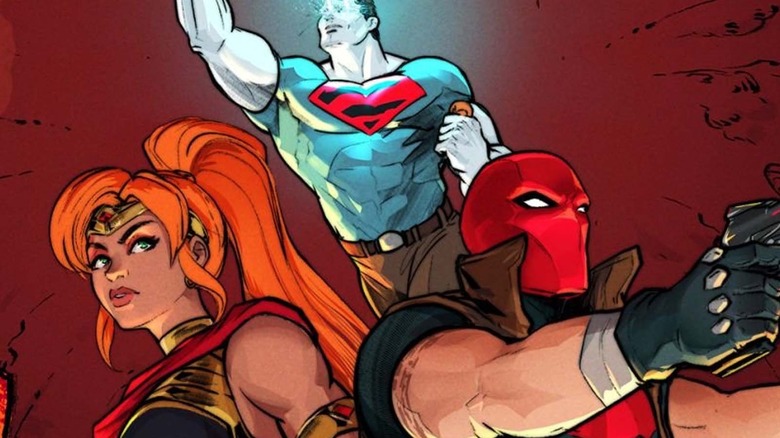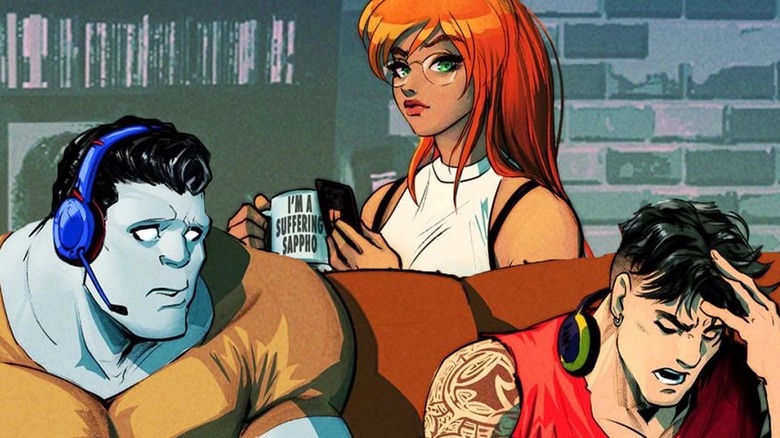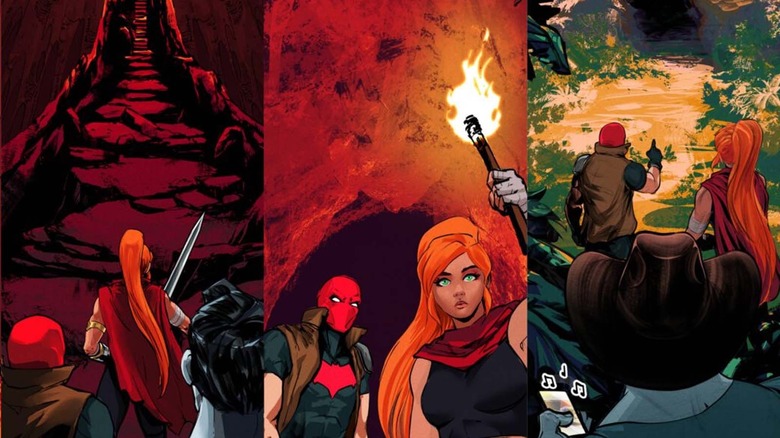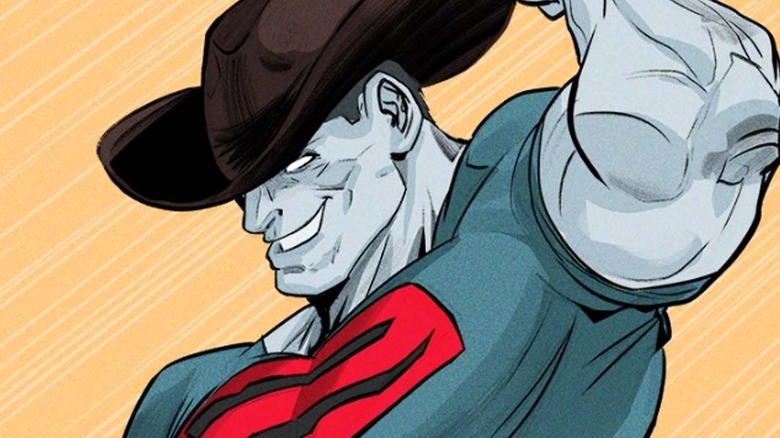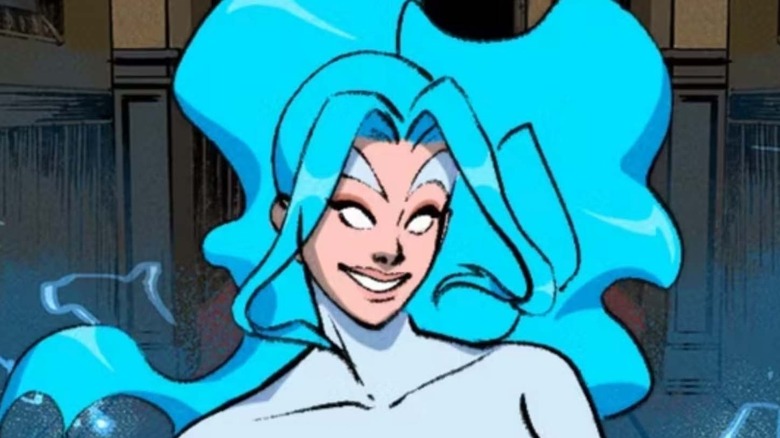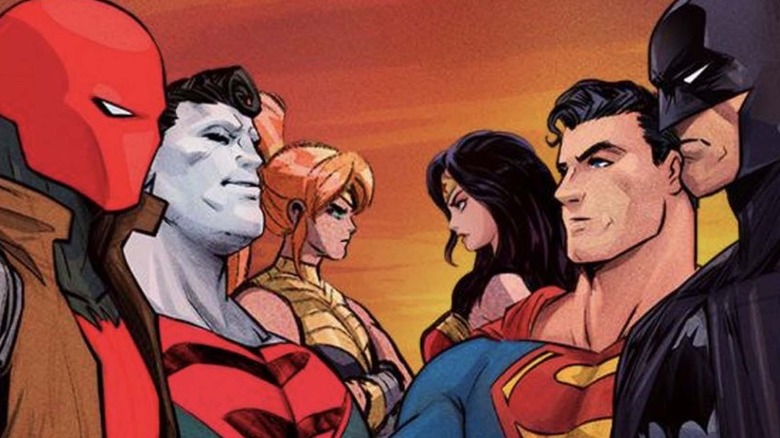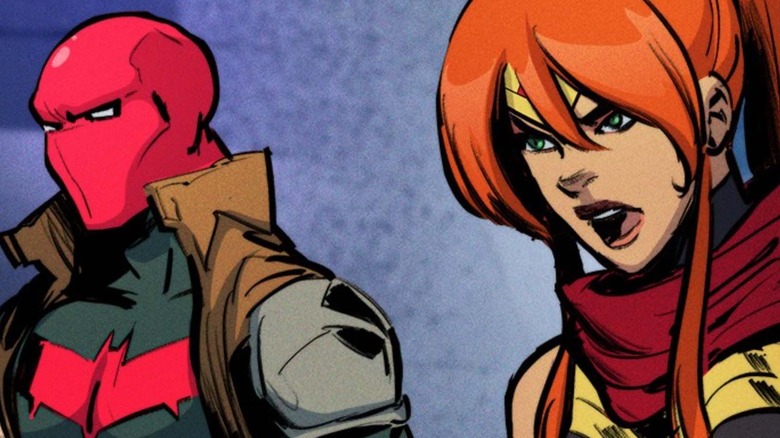Patrick R. Young And Nico Bascuñán Talk Red Hood: Outlaws - Exclusive Interview
Contains spoilers for "Red Hood: Outlaws"
Jason Todd, Bizarro, and Artemis' adventures at WEBTOONs in "Red Hood: Outlaws" are gearing up for the final stretch run of the series' first season. The comic has showcased the lives and relationships of each popular character: Red Hood has worked on his relationships with the Bat-Family, Bizzaro is trying to discover his own independence, and Artemis is balancing her romance with Jason Todd and history with Themyscira. The fan-favorite superteam of outcasts might be split up at the moment, but with 20 issues left in the online comic, readers can expect the heroes to band together once again as they show how much they genuinely care about one another.
We got the chance to speak with "Red Hood: Outlaws" writer Patrick R. Young and artist Nico Bascuñán about telling the story of Red Hood, Artemis, and Bizarro, their favorite dynamics of the team, recent surprise character introductions that cut deep within the DC lore, and what readers can expect in future issues.
Nearing the end of Season 1
You've nearly done 40 issues. How does it feel to be reaching the conclusion of Season 1?
Patrick R. Young: It's been a bittersweet process coming to the end — bitter because we've each spent two to three years with these characters in our heads and working on them and watching them grow and develop and change. Seeing that first season and all of that work come to an end is ... It's been hard. The last four scripts were the ones I wrote the slowest because I did not want the journey to end. But [it's] also very sweet and exciting because the last eight to nine episodes of the season are our most exciting and best, and I'm very, very excited for everyone to get to read that and see more of Nico's dynamic art.
Nico Bascuñán: It's quite a ride, man. It's such a long episodes, and I'm squeezing until the very last drop of the deadlines, pushing further the narrative and the visual. I'm very excited to tackle down the last episodes. I'm going to be in charge of those last episodes. I'm preparing for the final battle.
For those who don't know, who are the Red Hood and the Outlaws, and how have their relationships played a key part in this story?
Young: Red Hood is a former Robin of Batman's — Jason Todd. Artemis of Bana-Mighdall is an Amazon warrior, and Bizarro is a kind of backwards clone of Superman. They've all come together to form a vigilante group that works as a dark mirror of the Justice League. They've come together as outsiders and as literal outlaws with something in common and — in our series, especially — a lot to prove to other people and themselves as they search and try to find their own identities outside of the people they constantly get compared to.
How important was it to also showcase the relationships between Jason Todd and the rest of the Bat-Family? There's a particular issue where it's Jason talking to Dick, and they're talking about their relationship with Batman and to each other, and I thought it was a really tender moment.
Young: A lot of our series deals with each of these individual characters' growth and search for identities, and none of us live in isolation. These characters especially are very much products of their environment and how they were raised and treated in their early stages. A big part of that, especially for Jason Todd, is his family — especially Batman, but that includes his relationships to his brothers and everything. We didn't want to leave any of that untouched. And from a more selfish standpoint, I wasn't going to come into a DC series and not write Dick Grayson.
Bascuñán: I was in charge of that episode. It was a blast, man. I put more sauce on it, but we talked with the team ... That's one of our favorites with the Bizarro one, too — with the concert episode. The new one, the last episode on Fast Pass, is quite a good one too. It's made with all the love.
How the WEBTOONs style impacted the story
How did the WEBTOONs scroll style influence your writing the series, and how did it impact your drawing this "Red Hood" book?
Bascuñán: [In] my case, my drawings, it's always evolving, and particularly in my case, I don't smell my own style. It's weird. I have something in my mind and I draw it because I have no limits in style, but I only am doing what I like to my taste. With WEBTOONs, in the development stages, it's like the first 10 episodes, the next 10, and so on. It's evolving in accuracy more ... The faces and the expressions are more familiar. I don't know how many panels I've been drawing Jason and Bizarro and Artemis. So I will do it in a new style.
This is a blending of my style and something more quick to do with comics and with anime. It's very hard to achieve. My team struggles daily with that monster, [style-wise], and it's very weird — painted backgrounds, and we don't use 3D models at all. Everything is painted by hand like the old school. That's why it's a mix of my style and the house style. It's out of your reach. You never can catch it. I'm always trying to find the face of Jason, so it's evolving through all these parts.
Young: On my end, it is a very interesting and different challenge. You have to be very intentional because this is a series with a lot going on, and while we do have some episodes where we focus individually on characters, it is majoritively a team series and a lot of different plot lines going on. With the scrolling, never-ending format, we have to be very intentional with our transitions.
On one hand, I don't want to make any of the artists' jobs harder than they already are, even though I know they're always up to the task. In a typical comic book, you'd have the page turn as a transition. You could do a clean cut; you wouldn't have to worry about how everything connects in terms of making sure that the audience can read things and understand things and be clear with like, "Why are we here now?" Writing-wise and structurally, we've all had to be a lot more intentional in how we're communicating to the audience when we're switching things up.
Who are your favorite characters to write and draw?
Young: You're not going to catch me picking between the Outlaws. [laughs] I love them all.
Bascuñán: We have a favorite child.
Young: I love Bizarro because he's ... Compared to what I expected, Bizarro has been my favorite because he, on this emotional level, is a little bit more unexplored than especially Jason Todd. Jason Todd has a lot more straight content out there than both Artemis and Bizarro. We've had a lot of fun showing people Bizarro's different edges and sensitivities. Same with Artemis — she's had one mini solo series and a one-off recently last year.
We've really enjoyed being able to highlight how dimensional all these characters are. But I grew up dressing up and running around as Robin, so Jason Todd has been an absolute dream as well.
The importance of each team member
How does Bizarro represent the heart of the team?
Young: You see this in Episode 41, which — I don't know when this will come out, but it's about to come out as a non-Fast Pass episode. But he's the one who has recognized and is a bit more clear-eyed emotionally in terms of what the team needs and that they all are trying to do more with their both personal growth and as a team. Whether or not it's working in any given moment — because everyone's going through their own issues — he's very much the most active in trying to keep the team grounded and centered and true to who they are together as a family.
What about Jason Todd? He is technically the main character of this book. What's his importance to the Outlaws?
Young: It's been really fun, especially in this specific world where we're not tied to any specific continuity. It's been fun with such a big map and runway. The series is going to end with Chapter 60, so we've had a lot of space to run here. It's been nice being able to, specifically with Jason, know that we're going to have a lot of time and space to continually push him forward and up and in different directions.
Especially with legacy characters like him and with how often universes get reset, the character growth changes can take steps backward, or suddenly it's a different version of the character. It's been nice to know that we've had the space to watch Jason Todd try to find his own identity, both with a team, individually, and set apart from Batman. [We] see how he deals in those different situations as both a leader and someone who is learning to accept the more sensitive and vulnerable aspects of his personality as he falls in love and tries to manage a team within all of that.
What about Artemis? in Episode 39, she's split apart from the group in Valhalla. What's there for her, and how is she adjusting?
Young: Well, I don't want to get too much into spoilers, but I can say she is there to ... Like the other three during this split, she'll realize who she is in this world as an individual, and whether or not that leads to change or acceptance is ... I'm excited for people to see it. Then, on a more literal front, [there's] a new enemy.
Bascuñán: I'm literally drawing this episode that Patrick's talking about. I'm finished with it for this Sunday.
On that surprise cameo in Red Hood: Outlaws #39
Issue 39 ends with a surprise appearance of a fairly deep-cut character in Sharon Vance. How fun is it to pick out parts of the DC universe? You're like, "Oh, I want to write this character, I want to draw this character," and seeing it come to fruition.
Young: It's been an absolute blast ... Specifically in the spirit of the Outlaws, these are characters who, other than [in] the "Red Hood and the Outlaws" series itself in print run, haven't gotten as much attention as we think they deserve. A lot of the characters we fit in around them — and that's not going to change, that's only going to increase in the final 10 episodes — are also characters who have been unexplored, or who more modern audiences may or may not be more familiar with.
Sharon, specifically, is someone who's extremely powerful, extremely unique, and also — something I'm always looking for so our artists have fun — visually dynamic. She, as well as some very specific powers she has that fit into how these last 10 episodes are going to go, seemed like a natural fit for the story.
Nico, when you hear that you're going to get a new character like Sharon, is it daunting? Is it exciting? What is it like to have to be like, "Okay, now I've got to bring this character to life in my style and figure out how they fit into this book"?
Bascuñán: It's weird because when I read all the scripts, we split a lot of episodes. I want to highlight the second unit team because there are too many panels to do weekly. We divide a lot of chapters — you can see all the credits at the end of the episode. It's great because I let the team do whatever they want. That tyranny with that kind of, "The style has to be the same as me" — no, no, no. I don't work like that. I let the other artists interpret the script by themselves. I let them be themselves ...
I've enjoyed reading weekly too. I'm not putting my hands on those episodes; I'm resting for the end. My team is handling it in a very good way.
Young: We have a very large team, and there's a lot of trust there, but Nico is underselling a bit how much he's guided everybody on ... If he's not touching every episode, he is still mentoring and advising, and he is very much the ship's captain. We're very, very lucky to have him.
Bascuñán: When you see in the credits "Art Lead," it's because I'm just looking. I'm saying, "No, I like that" or "Let's change that." But everyone puts their soul into this series. I'm very glad with the results. I'm very excited to show what we are going to do at the end, because it's on me. I'm going to do very experimental things we talked about last year with Patrick. We have prepared some great surprises at the end, I think. I don't know the end.
The importance of solo issues and what readers can expect from the rest of Season 1
How important was it for each Outlaw to get their own starring issues? And how will that contribute to them finding each other again?
Young: It was important for us to be able to highlight their individual psyches. During team-focused episodes, it can be a little harder because while we do have a huge runway, each individual WEBTOON chapter is only so long. It's a little harder sometimes to explore what an individual character is thinking on a larger scale.
To be able to have the space to focus on them one by one — specifically for this kind of story, where they're trying to find out who each other is, both as they fit inside the team and as individuals in this larger universe — it's been very useful to be able to focus on one at a time at any given moment if we want to. The lessons they learn on each of those individual journeys show them what they value in this world and how they want to lead themselves moving forward. Hopefully, that leads them back together, but who knows?
As the series is reaching its final third, what can readers expect? How excited are you to tell these final chapters?
Young: The last eight or so issues are our best work. I'm very excited for people to see and hopefully understand a lot of the previous episodes — why certain pieces of information were revealed, why certain other pieces of information weren't revealed. How we are telling the story is all structured very specifically to lead up to this longer arc that we finish off the season with.
We're going to have it all — love, action. Again, I can't say anything too specific ... One of the cool things about all these different DC WEBTOONs series is they've let each of us have such differing identities. "Wayne Family Adventures" is mostly one-offs; they have a couple of two- to three-episode arcs, but there's shorter stories over there. "Zatanna" was one specific, long mystery. We've had a lot of four- to five-episode arcs. But the one thing that we've maintained, and the true story of our series, is each of the individual Outlaws — the emotional arcs and growth and searches for identity. That's all led to this.
As they have in some of the Bizarro episodes and these two recent Jason episodes, seeing the Outlaws come together, I hope everyone can ... I'm excited for everyone to connect emotionally and understand these characters and identify with these characters — and hopefully, want to see more of them.
Bascuñán: The last bit is going to be emotional, man. I'm going to save all the last bullets till the end. I'm showing some pills during the entire series, but the end is going to be crazy. That's my only goal with this because I enjoy all the series.
Young: Yeah, it's been an absolute dream.
Bascuñán: I did my best with the end. I hope you like the experiments I have in mind with the transition, the pace, and the rhythm.
A tease at what's coming next in Red Hood: Outlaws
"Red Hood: Outlaws" on WEBTOONs has 20 issues left in its 60-issue first season, and we've got a first look at what's coming soon in the comic. Check out the following preview, which features Dick Grayson and Jason Todd grabbing a beer while playing darts, a revisiting of a classic Robin suit, Jason meeting with Barbara Gordon, and the antihero getting a hug from Alfred Pennyworth.
"Red Hood: Outlaws" is available for free to read on the WEBTOONs app and website now.
This interview has been edited for clarity.
